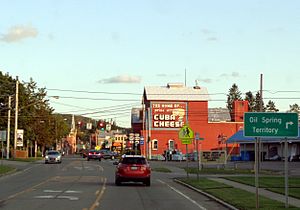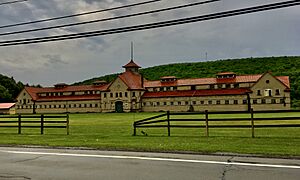Cuba, New York facts for kids
Quick facts for kids
Cuba, New York
|
|
|---|---|

Town center along Genesee Street
|
|
| Country | United States |
| State | New York |
| County | Allegany |
| Government | |
| • Type | Town Council |
| Area | |
| • Total | 35.80 sq mi (92.73 km2) |
| • Land | 35.10 sq mi (90.91 km2) |
| • Water | 0.70 sq mi (1.82 km2) |
| Population
(2020)
|
|
| • Total | 3,126 |
| • Estimate
(2022)
|
3,102 |
| • Density | 89.06/sq mi (34.39/km2) |
| Time zone | UTC-5 (Eastern (EST)) |
| • Summer (DST) | UTC-4 (EDT) |
| FIPS code | 36-003-19367 |
Cuba is a small town located in Allegany County, New York. It sits on the western edge of the county. Inside the town of Cuba, you'll find the village also called Cuba.
A special area for the Seneca Native Americans is located on the western border of the town. In 2020, about 3,154 people lived in the town of Cuba.
Contents
- Exploring Cuba: Geography
- Why is it Called Cuba?
- People in Cuba: Demographics
- A Look Back: History
- Local Business: Cheese Capital
- Fun Places to Visit: Points of Interest
- Learning in Cuba: Education
- Places of Worship: Churches
- Resting Places: Cemeteries
- Famous People from Cuba
- Images for kids
- See also
Exploring Cuba: Geography
The town of Cuba covers about 35.8 square miles. Most of this area is land, with a small part being water.
The western border of Cuba touches Cattaraugus County. Major roads like Interstate 86 and New York State Route 17 (also known as the Southern Tier Expressway) run through the town. New York State Route 305 is another important road that goes north and south.
Cuba is also on a main railroad line. This line is operated by the Western New York & Pennsylvania Railroad.
Places in the Town of Cuba
Here are some of the communities and interesting spots you can find in the town of Cuba:
- Cuba – This is the main village within the town.
- Cuba Lake – A beautiful lake in the northwest part of the town.
- North Cuba – A small hamlet (a tiny community) located north of Cuba village.
- Oil Springs Creek – A stream that flows through the village of Cuba.
- Oil Springs Reservation – A special area for the Seneca people on the western town line.
- South Cuba – Another small hamlet south of Cuba village.
- Summit – A spot east of Cuba village, sometimes called "Cuba Summit."
- Tannery Creek – A stream that crosses the town and goes through Cuba village.
Neighboring Towns
Cuba is surrounded by other towns:
- To the north is New Hudson.
- To the south is Clarksville.
- To the east is Friendship.
- To the west is Ischua in Cattaraugus County.
Why is it Called Cuba?
You might think Cuba, New York, was named after the island of Cuba. But that's not the case!
According to a book from 1910, the name "Cuba" is a Roman word. It means "Goddess or Protector of the Young." It's thought that the people who created the town in 1822 simply liked the sound of the word.
Simeon DeWitt, a surveyor for New York State, loved ancient Roman stories. He is believed to have suggested the name.
Even though there are other towns nearby with Spanish names like Salamanca and Panama, Cuba's name comes from a different origin.
People in Cuba: Demographics
| Historical population | |||
|---|---|---|---|
| Census | Pop. | %± | |
| 1830 | 1,059 | — | |
| 1840 | 1,768 | 66.9% | |
| 1850 | 2,243 | 26.9% | |
| 1860 | 2,187 | −2.5% | |
| 1870 | 2,397 | 9.6% | |
| 1880 | 2,203 | −8.1% | |
| 1890 | 2,328 | 5.7% | |
| 1900 | 2,369 | 1.8% | |
| 1910 | 2,431 | 2.6% | |
| 1920 | 2,395 | −1.5% | |
| 1930 | 2,256 | −5.8% | |
| 1940 | 2,507 | 11.1% | |
| 1950 | 2,784 | 11.0% | |
| 1960 | 3,116 | 11.9% | |
| 1970 | 3,165 | 1.6% | |
| 1980 | 3,428 | 8.3% | |
| 1990 | 3,401 | −0.8% | |
| 2000 | 3,392 | −0.3% | |
| 2010 | 3,243 | −4.4% | |
| 2020 | 3,154 | −2.7% | |
| 2022 (est.) | 3,102 | −4.3% | |
| U.S. Decennial Census | |||
In 2000, there were 3,392 people living in the town of Cuba. About 1,336 homes were counted. The population density was about 96 people per square mile.
Many families lived in Cuba, with 53.4% being married couples. About 31.7% of homes had children under 18 living there. The average household had about 2.49 people.
The population was spread out by age. About 25.7% were under 18. The median age was 40 years old.
A Look Back: History
The town of Cuba was created in 1822. It was originally part of the town of Friendship. Later, parts of Cuba were used to form other towns. These included the town of Genesee in 1830 and the town of Clarksville in 1835.
Settlers first arrived in Cuba around 1817. The town grew quickly between 1810 and the late 1820s. Many of the town's first businesses, churches, and schools were started during this time. The village of Cuba was officially recognized in 1850.
Local Business: Cheese Capital
Cuba's Cheese History
Starting in the 1870s, Cuba became very important for making cheese in New York. Its location near railroads made it easy to send cheese to places like New York City. Because of this, in the early 1900s, Cuba was even known as the "Cheese Capital of the World"!
Fun Places to Visit: Points of Interest
Cuba Lake
Cuba Lake is a lake that was made by people. It's about 2 miles north of the village of Cuba. The lake is 1,542 feet above sea level. It's the highest reservoir in Allegany County.
The lake was built in 1858. It cost $150,000 to build. Its original purpose was to supply water to the Genesee Valley Canal. When it was built, Cuba Lake was the largest man-made lake in the world! Today, people mostly use the lake for fun activities. You can find many fish there, like bass and walleye.
More than 300 homes are built around the lake. Many people live there all year. The road around the lake is about 7 miles long.
The Seneca Oil Spring
The Seneca Oil Spring is a famous natural spring. It's located near Cuba Lake, on the Oil Springs Reservation. This spring is special because it's where oil was first mentioned in North America. A missionary named Joseph de La Roche Daillon wrote about it in 1627.
In 1927, a monument was placed at the site. It tells the story of the oil industry in North America. Today, Allegany County looks after the site. There's even a picnic area for visitors.
McKinney Stables
Cuba is also home to the McKinney Stables of Empire City Farms. Locals often call it the Block Barn. It's located south of the historic part of town. This huge building was built in 1909. It's almost 350 feet long and made mostly of cement. This makes it completely fireproof!
The stables were built to house William Simpson's special "McKinney" horses. It was a very popular stable. Even the Czar of Russia sent a horse there to be bred. The Anheuser Busch company once thought about using it for their famous Clydesdale horses. Every September, the stables host the Cuba Garlic Festival.
The McKinney Stables were added to the National Register of Historic Places in 1999.
Learning in Cuba: Education
Local Schools
The main high school in Cuba is Cuba-Rushford Middle High School. This school was formed when the Cuba and Rushford school districts joined together. The Middle High School teaches grades 6-12. It is located north of town on Route 305.
The building known as the "Old" High School now teaches grades K-5. The "Old" Elementary School across the street is now the Elm Street Academy. This is part of a BOCES program. The school mascot used to be the Greyhounds. After the merger in the mid-1990s, the mascot became the Rebels. The Rebel's mascot looks a bit like Yosemite Sam.
Higher Education Nearby
There are several colleges and universities close to Cuba.
- St. Bonaventure University (SBU) is west of Cuba. It's between the villages of Allegany and the city of Olean. SBU's sports teams play in the Atlantic 10 Conference.
- Olean also has a campus for Jamestown Community College.
- About 30 miles east of Cuba, in Alfred, you'll find Alfred University and Alfred State College.
- Houghton College is about 20 miles north of Cuba, in Houghton.
Places of Worship: Churches
- Cuba First Baptist Church
- Christ Church (Episcopal)
- Cuba United Methodist Church
- Our Lady of Angels (Catholic)
- North Park Wesleyan Church
- The Church Project
Resting Places: Cemeteries
- Cemetery - (Town 3, Range 2HC, lot 45), Cuba Village
- Cemetery - (lot 54), Witter Road
- Cemetery - (lot 45), Cuba Village
- Catholic Cemetery - (lot 45), Cuba Village
- North Cuba Cemetery - (lot 47), near Cuba Dam
- Cemetery - near Cuba Lake
Famous People from Cuba
- Charles Ingalls: He was the father of Laura Ingalls Wilder. She wrote the famous Little House on the Prairie books. Charles was born on a farm in the North Cuba area. Many of his family members lived there before 1835.
- General Calvin T. Chamberlain: He was a brigadier general in the New York State Militia. He opened a store and was the Postmaster of Cuba in 1835. He also served in the New York State Assembly and Senate.
- Charles Edwin "Charley" Ackerly: Born in Cuba, he won an Olympic gold medal for wrestling. This was at the 1920 Summer Olympics in Belgium.
- William Orton: He was the President of Western Union, a major communications company.
- Edward B. Vreeland: Born in Cuba, he was a politician. He served as a U.S. Representative.
- James Pond: He was a strong supporter of ending slavery. He also won a Medal of Honor for his service during the American Civil War.
- Joseph Hupp: A notable chemist.
Images for kids
See also
 In Spanish: Cuba (pueblo) para niños
In Spanish: Cuba (pueblo) para niños





